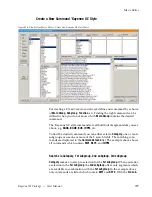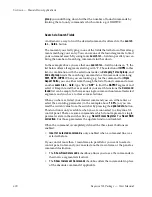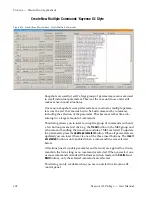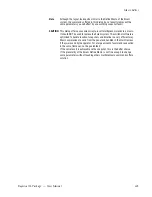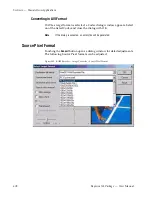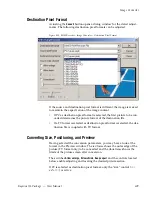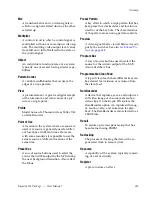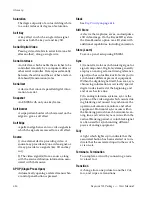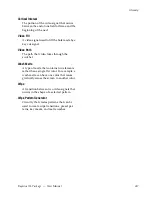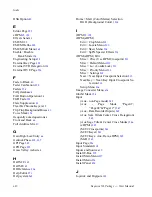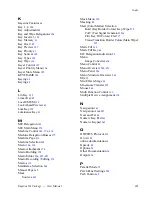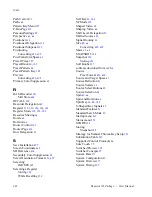
Kayenne XL Package — User Manual
613
Glossary
Field
One scan of an interlaced video image. In in-
terlace systems, two fields are required to
make a complete picture (video frame) be-
cause alternate lines are scanned.
Fill Video
A video signal which fills a hole cut in back-
ground video by a key control signal.
Flip-Flop
A transition where the sources selected on
the background buses (for example, preset
and program) of an M/E are exchanged at
the end of a transition. The original preset
bus source becomes selected on the program
bus, and the original program bus source be-
comes selected on the preset bus.
FPGA
Field Programmable Gate Array.
Frame
One complete scan of a video image. For in-
terlace video, alternate lines are scanned, and
so a frame containing all the picture informa-
tion consists of two fields.
Frame Rate
The number of frames presented per second.
For interlace systems the frame rate is half
the field presentation rate.
Gain
An amplification factor applied to a key con-
trol signal by a keyer that determines how
much, if any, of the background and key fill
video will be mixed together at the key edge
areas. Low gain (1, or unity) generally results
in a linear key.
General Purpose Interface (GP)
An interface that enable limited remote con-
trol of some of a device’s functions.
GPI
General Purpose Interface Input
GPO
General Purpose Interface Output
General Purpose Interface (GPO)
An interface that enable limited remote con-
trol of some of a device’s functions.
House Sync
Sync generated within a facility that is used
as a reference for generating and/or timing
other signals.
Hue
The location of a color on the color spectrum
(i.e. red, yellow, green, blue). Chroma, hue,
and luminance make up the three character-
istics of television color.
Interlace
A system of video scanning where the odd
and even numbered lines of a picture are pre-
sented consecutively as two separate inter-
leaved fields. The two fields required to
make a complete picture are called a frame.
Jitter
An undesirable variation in the timing of
transitions in a digital signal.
Positioner
A hardware positioner with control of multi-
ple axes.
Key
An effect where a portion of a background
scene is replaced by a new video. Key cut
and key fill signals are involved, though in
some cases the same signal may be used for
both (self key).
Key Cut
In key effects, the key cut signal is used to
specify where to cut a hole in the background
that will be filled with the key fill video. The
key cut signal determines the shape of the
key effect.
Summary of Contents for Kayenne XL Package
Page 82: ...82 Kayenne XL Package User Manual Section 2 Concepts ...
Page 264: ...264 Kayenne XL Package User Manual Section 4 Menu Overview ...
Page 275: ...Kayenne XL Package User Manual 275 Status Menu M E Mapping Submenu In Preparation ...
Page 285: ...Kayenne XL Package User Manual 285 Install Menu Figure 217 Install E Box Tally In Assign ...
Page 347: ...Kayenne XL Package User Manual 347 Config Menu Figure 282 Config Copy Simple Menu ...
Page 352: ...352 Kayenne XL Package User Manual Section 5 Menu Summaries Figure 285 Example ...
Page 434: ...434 Kayenne XL Package User Manual Section 5 Menu Summaries Figure 345 Chroma Key Main ...
Page 435: ...Kayenne XL Package User Manual 435 Key Menu Figure 346 Chroma Key Main Cursor ...
Page 437: ...Kayenne XL Package User Manual 437 Key Menu Figure 348 Chroma Key Suppression Cursor ...
Page 462: ...462 Kayenne XL Package User Manual Section 5 Menu Summaries ...
Page 487: ...Kayenne XL Package User Manual 487 RamRecorder Menu Figure 405 Export Dialog 2 ...
Page 509: ...Kayenne XL Package User Manual 509 Scaler Menu ...
Page 583: ...Kayenne XL Package User Manual 583 EMEM Menu Figure 472 EMEM Edit Insert Trigger Macro Number ...
Page 590: ...590 Kayenne XL Package User Manual Section 5 Menu Summaries ...
Page 618: ...618 Kayenne XL Package User Manual Glossary ...

